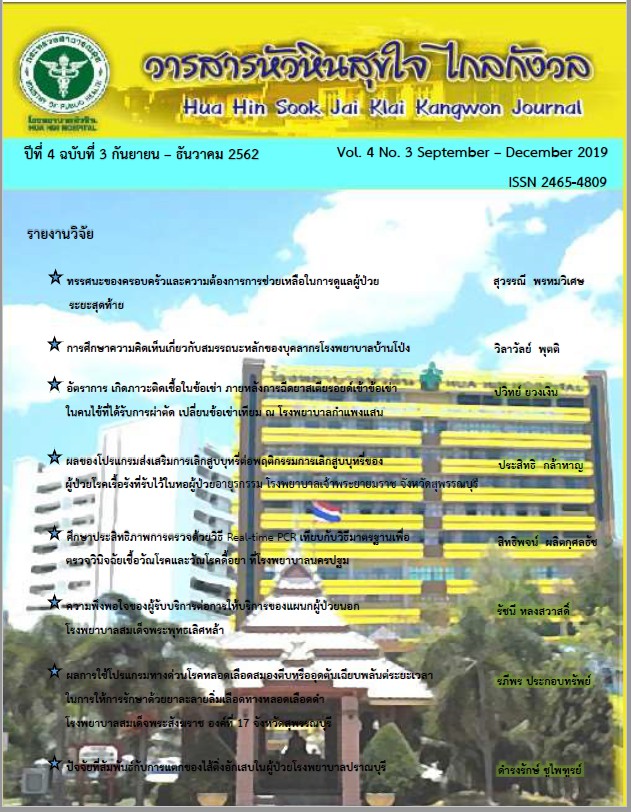Family Caregivers’ Perspectives and Support Needs in Caring for End-Stage Patients
palliative care
Keywords:
perspectives, end-stage patientAbstract
The aims of this descriptive research were to explore the level of family perspectives and support needs on caring for end-stage patient’s family. The samples were to caretakers of end-stage patients who admitted to Vibhavadi, Chaiya, Tha Chang and Khiriratnikhom hospital between 29 October – 10 November 2019. 30 purposive samplings were selected from 4 hospitals.
Research findings found that the thoughts, beliefs, and spiritual need of patient’s families were found to have a large impact and used as a way of living and they wished to do for the rest time of patient's life by wanting to die naturally was at a high level ( =3.77, SD=0.48) (
=2.41, SD=0.47). However, physical discomfort and emotional conditions were found at a moderate level (
= 2.88,SD=1.81).The needs of patient’s families were found at the high level such as they needed to get information about diseases and the progression of their treatment in every day (
=2.97,SD=0.18). Follow by patients needed as living with family members all the time of end stage in order to their support and got batter emotional status. (
=2.77,SD=0.43). In terms of spiritual needs, Buddha practice and the places for doing their religion practice which related to their beliefs were indicated at the low level needs (
=1.50, SD=0.86) This findings can be directed healthcare service networking to improve clinical practice guideline for end-stage patients. This guideline must be enclosed problems and support needs in caring for end-stage patients and their family. In order to take care end-stage patients appropriately.
References
2. กองยุทธศาสตร์และแผนงาน. สถิติสาธารณสุข.นนทบุรี. สำนักงานปลัดกระทรวงสาธารณสุขกระทรวงสาธารณสุข; 2561.
3. กรมการแพทย์.แนวทางการดูแลผู้ป่วยระยะสุดท้าย. กรุงเทพมหานคร: กรมการแพทย์ กระทรวงสาธารณสุข; 2557.
4. จอน ผะจงเพ็งจาด. บทบาทพยาบาลในการดูแลผู้ป่วยแบบประคับประคอง. วารสารวิทยาลัยพยาบาลบรมราชชนนีกรุงเทพ 2557; 30(1): 100-109.
5. เยาวลักษณ์ คุมขวัญ. การเตรียมความพร้อมของญาติเพื่อส่งเสริมการตายอย่างสมศักดิ์ศรีในผู้ป่วยระยะสุดท้าย. วารสารวิจัยราชภัฎพระนคร 2559; 11 (2): 125-138.
6. งานเวชสถิติ โรงพยาบาลวิภาวดี. สถิติข้อมูลโรงพยาบาลวิภาวดี. สุราษฎร์ธานี; 2561.
7. ประนอม โฉมกายและคณะ. ประสิทธิผลของการประชุมครอบครัวของผู้ป่วยระยะสุดท้ายโรงพยาบาลชลบุรี. [อินเตอร์เน็ต]. 2562 [เข้าถึงเมื่อ 1 ธ.ค. 2562] เข้าถึงได้จาก : https://www.cbh.moph.go.th.
8. เพชรน้อย สิงห์ช่างชัย. หลักการและการใช้สถิติการวิเคราะห์ตัวแปรหลายตัว สำหรับการวิจัยทางการพยาบาล. พิมพ์ครั้งที่ 3. สงขลา: ชานเมืองการพิมพ์; 2549.
9. สำนักงานหลักประกันสุขภาพแห่งชาติ. นโยบายและแนวปฏิบัติการดูแลประคับประคองและระยะสุดท้าย. กรุงเทพมหานคร. กรมการแพทย์; 2558.
10. พิมพ์พนิต ภาศรี. ทรรศนะของครอบครัวและความต้องการการช่วยเหลือในการดูแลผู้ป่วยมะเร็งระยะสุดท้าย. [วิทยานิพนธ์]. สงขลา: มหาวิทยาลัยสงขลานครินทร์; 2557.
11. William Sullivan. Ethical and Spiritual Issues at
the End of life: The Relevance of Spiritual Care to Biothics. Bioethics [Internet]. 1984 [Update, 2003; 3(2):cited 21 2019 May21]. Available from: https://www.utoronto. ca/stmikes/bioethics.
12. ปราณี อ่อนศรี. บทบาทพยาบาลกับการดูแลผู้ป่วย
Downloads
Published
How to Cite
Issue
Section
License
บทความที่ได้รับการตีพิมพ์ในวารสารหัวหินเวชสาร เป็นลิขสิทธิ์ของโรงพยาบาลหัวหิน
บทความที่ลงพิมพ์ใน วารสารหัวหินเวชสาร ถือว่าเป็นความเห็นส่วนตัวของผู้เขียนคณะบรรณาธิการไม่จำเป็นต้องเห็นด้วย ผู้เขียนต้องรับผิดชอบต่อบทความของตนเอง







